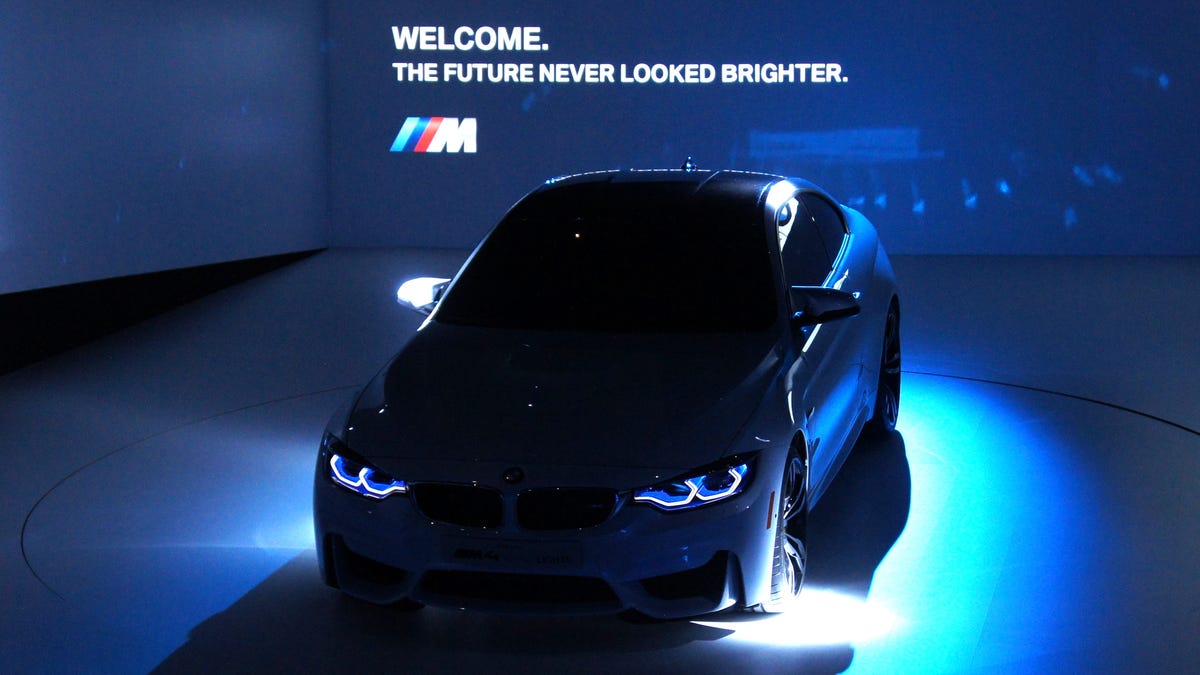BMW lighting does more than illuminate the road
At CES 2015, BMW showed off its M4 Concept Iconic Lights, using laser lights and organic light emitting diodes to show futuristic capabilities of automotive lighting.

LAS VEGAS -- With its M4 Concept Iconic Lights, BMW showed how advanced technology can revolutionize automotive lighting. Laser headlights have the ability to very specifically shape the thrown light, and even add driver assistance features. Rear organic light emitting diodes (OLED) make for an efficient and flexible tail light.
In a darkened demonstration room, BMW showed a video of what the driver of the M4 concept car would see. The laser headlights themselves throw light up to 650 yards, much further than even LED headlights. The laser light, reflected through filters, will not blind or harm pedestrians, and the laser diodes use a fraction of the electricity of modern headlights.
The demonstration video showed how the lighting pattern dynamically illuminates a turn in the road. Taking this concept further, a camera in the car can identify potential hazards on the road ahead, such as deer or pedestrians. The headlights then can throw a spotlight on that specific area, alerting the driver to the hazard. BMW currently has this technology available in Germany, but Department of Transportation rules will need to change in order to make this type of headlight legal in the US.
Detecting a car on the road ahead or oncoming traffic, the headlights dynamically create a dark spot that tracks the other car. For oncoming traffic, the headlights avoid blinding the driver, while drivers in front don't have to deal with bright reflected light in their rearview or side mirrors.
The most innovative feature had the headlights serving as a driver-assistance feature. BMW's video showed an instance where a large truck was crowding the lane ahead. The headlights used the car's camera data to paint lines on the road for the driver, between the truck and the roadside barrier. When the system's computer determined the space was too narrow for the M4, it painted a warning sign for the driver not to attempt to pass.
BMW's Thomas Hausmann, in charge of lighting systems for the company, explained that each headlight uses two laser light modules with motorized mounts. These mounts can turn to create the dark area so as not to blind other drivers.
OLED tail lights
The rear of the M4 Concept Iconic Lights was marked by OLED panels for the tail lights, the same material beginning to find use in televisions. The upper part of the panel could show a traditional yellow turn signal while the lower majority was red, to indicate tail lights. As the display properties are completely flexible, BMW could make the entire panel red, blink or change shapes for signals to following drivers.
The OLED tail lights appeared to be bright enough to be seen in the day time. BMW's demonstration video pointed out that the panels were about 0.1 inches thick, so they would create very little intrusion on the car's body. OLEDs are also extremely energy-efficient.
Hausmann explained that this OLED tail light was still a couple of years from production. The OLED panels BMW is testing are not quite up to automotive quality, as they would have to survive temperatures up to 80 degrees Celsius (176 degrees Fahrenheit). He mentioned that BMW expects the lights to retain 70 percent of their illumination after 10,000 hours of use, but they are not currently up to that standard.
Computing technology has already significantly improved automotive drivetrains, suspension and steering. In the cabin, electronics make for much more flexible and useful infotainment systems, and enable driver-assistance systems which enhance safety. Now it appears that computers will even change the way cars light the road.

